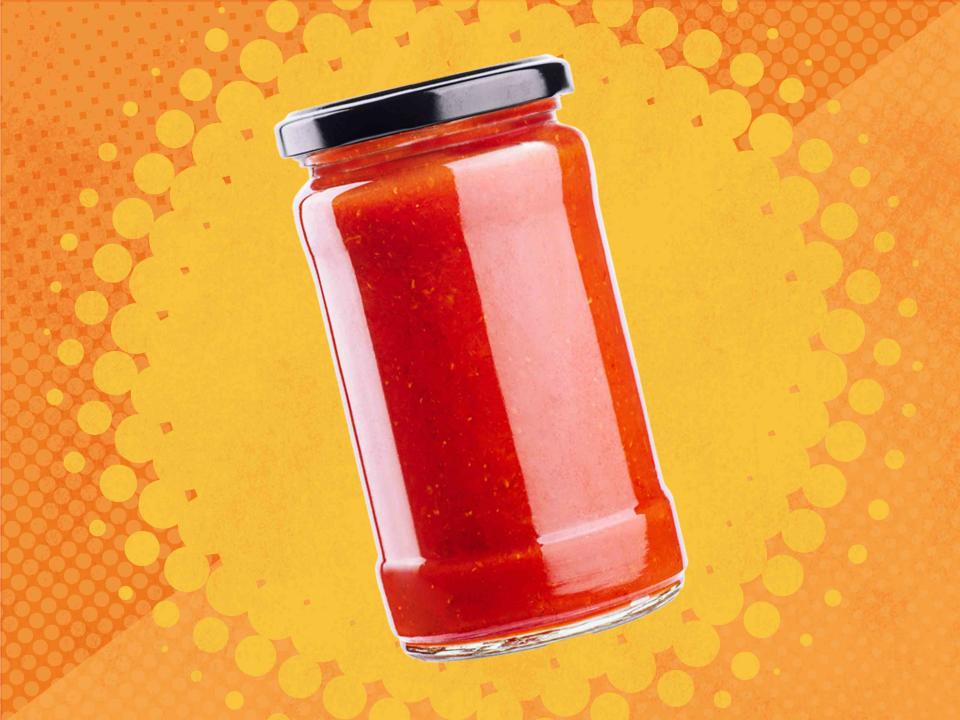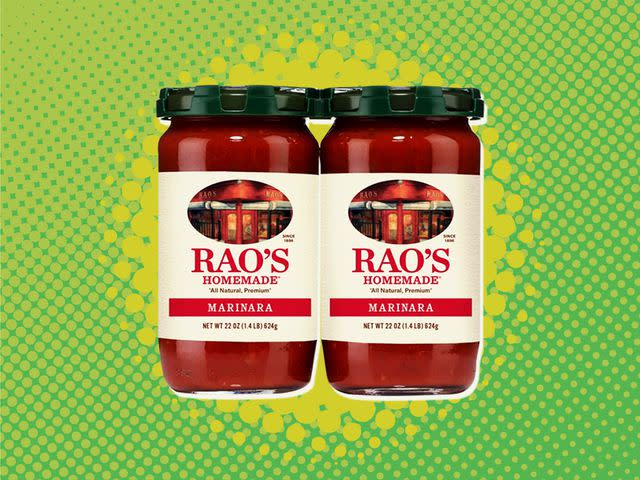I Asked Chefs to Pick The Best Pasta Sauce and They All Chose This Brand
There was one clear winner.

Getty Images
When time allows, we’re all for a good Sunday sauce. Not only can we customize the flavors when we DIY, but also who needs an air freshener when you have a big pot of pasta sauce simmering on the stove?
Still, we don’t always have time to make sauce from scratch, and we hear from many AllRecipes readers that you, too, consider jarred pasta sauce as one of your pantry staples. And there’s no shame in that, especially when many supermarkets have an entire half an aisle full of solid options. Even the man who wrote the book on pasta, Dan Pashman, has said "Why make your own tomato sauce when there are so many high-quality jarred varieties available today?”
We wholeheartedly agree, so we asked Pashman and two other chefs and cookbook authors to help us narrow down all of the options. While we technically spoke to three brilliant food folks for this piece, five food pros have actually declared this as their marinara MVP. That’s because these chefs selected the same pasta sauce that’s Kristin Cavallari’s go-to and Ina Garten's favorite!
Our Panel of Pasta Sauce-Judging Chefs and Cookbook Authors
Meggan Hill, the Valencia, California-based executive chef and CEO of Culinary Hill
Yumna Jawad, the Grand Rapids, Michigan-based CEO and founder of Feel Good Foodie and the author of "The Feel Good Foodie Cookbook: 125 Recipes Enhanced with Mediterranean Flavors"
Dan Pashman, the New York City-based host of The Sporkful podcast, inventor of the cascatelli pasta shape, and author of "Anything's Pastable: 81 Inventive Pasta Recipes for Saucy People"
What To Look for When Buying Jarred Tomato Pasta Sauce
There are dozens—sometimes more than 100—options for pasta sauces at a single supermarket. We tend to find tomato sauces to be the most versatile, so that’s what we’re focusing on here. With that in mind, here’s what our culinary panel looks for on the label to determine if a sauce is worthy of a spot in their cart.
The first ingredient is tomatoes.
“The first ingredient should be tomatoes, not tomato puree,” Pashman says, adding that this shouldn’t be groundbreaking, but isn’t always the case. Any of these synonyms for real tomatoes are A-OK in that first slot, he continues:
Whole peeled tomatoes
Crushed tomatoes
Italian plum tomatoes
San Marzano tomatoes
Oven-roasted tomatoes
On the flip side, “tomato puree is typically tomato paste mixed with water, and often preservatives—it’s the sauce equivalent of juice made from concentrate instead of fresh-squeezed,” Pashman clarifies. “It’s okay if some tomato puree is included, but I want a sauce that starts with actual tomatoes.”
There is no added sugar.
This isn’t necessarily for health reasons, although eating fewer added sugars is generally a savvy strategy for overall well-being. The real reason why Pashman, Jawad, and Hill seek out no-sugar-added sauces is that “if you have ripe tomatoes, good seasoning, and herbs, there is absolutely no need for added sugar in jarred pasta sauce,” Jawad explains. “After all, it’s not something normally found in authentic pasta sauce in Italy!”
Just five or 10 years ago, when low-fat diets reigned supreme and sugar sometimes stood in for the subtracted fat, “sugar-free pasta sauces were hard to find or extremely expensive, but now they are widely available and even popular,” according to Hill. “Many families eat too much sugar as it is, mine included, and it's an easy ingredient to avoid. Nobody even misses it!”
It’s free of preservatives.
Similar to our Best Marinara Sauce Yet, which calls simply for tomatoes, herbs, onion, garlic, white wine, and olive oil, Hill seeks out store-bought sauces that include ingredients she knows on the label. She checks the list to ensure it doesn’t include “fillers or other random ingredients,” she tells us.
Jawad seconds that, adding that she particularly keeps an eye out for preservatives: “Due to the acidity of tomatoes and the sterilization process during canning, jarred pasta sauce shouldn’t need any preservatives in my opinion.”
You enjoy the flavor.
Above all, you should seek out a sauce that tastes best to you, Pashman says. Every individual’s answer might vary a bit, however, our experts typically gravitate towards sauces with:
Fresh tomato flavor
A balance of sweetness and acidity
Any additional ingredients beyond tomatoes are complementary without being overpowering
The Best Store-Bought Pasta Sauce, According to the Pros

Dotdash Meredith / Janet Maples
Considering those factors, and the overall flavor, texture, and versatility, which brand earns the MVP award?
The Pasta Queen, Carbone, and Victoria are all worthy contenders and earn hat tips as solid options from our panel, but the unanimous victor is the pasta sauce that you, our readers, selected as the winner of our Community Choice Awards. It’s also one of five brands that you told us are “worth the splurge” at the grocery store.
And our chefs agree: The best store-bought pasta sauce is Rao’s. Jawad adores the fact that the ingredient list is simple and only includes items “that I can easily recognize and pronounce.”
Rao’s actually offers more than two dozen different red sauces, but if we look at Ina’s recommended Homemade Marinara Pasta Sauce, the ingredient list is streamlined: Italian whole peeled tomatoes, olive oil, onions, salt, garlic, basil, black pepper, and oregano.
Hill chimes in, “All of Rao's sauces are delicious and ready to use on their own. They need no doctoring or additional ingredients,” she explains. “They have great consistency—pleasantly thick without being too watery—and great flavor. It tastes like it's homemade, like I made it myself. The fact that it doesn't contain sugar is a bonus! Most other popular store-bought brands do.”
If you prefer to go beyond classic marinara, Rao’s just released two new flavors. They’re also the brand behind the best jarred pizza sauce, according to our taste tests. Hill and her family actually prefer to use the pizza sauce as their pasta sauce, since it’s the just-right size for their small crew. (For reference, Rao’s Homemade Pizza Sauce is sold in 12.3-ounce jars. The pasta sauces are available in 24-ounce jars, and open jars of pasta sauce last in the fridge for 5 to 6 days. Can’t make it through an entire jar before it might go bad? You can always freeze it.)
The red sauce line of Rao’s also includes options that range from tomato-basil to Bolognese and spicy arrabbiata to a sensitive marinara that’s garlic- and onion-free.
How to Use Pasta Sauce Like a Chef
Regardless of which Rao’s red sauce you choose, options abound to celebrate the chef-approved sauce in that jar.
Tossing it with these top-tier cuts of pasta. Pashman admits that he’s biased, but adores Rao’s pasta sauce most with his own thoughtfully-engineered noodle, cascatelli. “I invented this pasta shape especially to hold a ton of sauce!” As for Jawad, she jives with any flat ribbon-like pasta, such as fettuccine or pappardelle, since “the surface area holds the sauce really well without it falling to the bottom of the plate.” When Hill is feeding her family, she adores twirly cavatappi noodles “because the chunks of onions and tomatoes in the sauce can get lodged in the swirls—I love that!”
Make it your own. While the foundation of Rao’s pasta sauce is certainly tasty enough to use on its own, it can be just the beginning of your taste bud adventure, if you like. Giada de Laurentiis, for one, likes to use it for shortcut vodka sauce. For a variation on that theme that Kendall Jenner digs, try Pasta alla Tequila. Or customize it according to your personal preferences by following Pashman’s lead. His cookbook includes a “Jarred Tomato Sauce Decision Tree” that looks at what readers are craving, be it spice, crunch, heartiness, meat, or texture. “Follow the prompts you'll end up with one of more than a dozen options for jazzing up a basic jar of sauce, whether it's mashing in a can of beans, taking inspiration from the Indian dish matar paneer, or adding a roasted eggplant or tablespoon of miso,” he explains.
Add meat. Both Hill and Jawad are keen on pumping up the protein. Jawad frequently cooks ground beef and onions to mix with Rao’s red sauce, while Hill swears that incorporating cooked ground beef and Italian sausage “really makes a special meal. It's hearty, filling, and tastes like the sauce my grandma used to make.” After mixing this spiffed-up, meaty Rao’s sauce with pasta, “I finish it with a dusting of Parmesan cheese—always the one from the green shaker can. That's the stuff food memories are made of.”
Try it in a pasta-free recipe. Who says you need noodles at all? Tomato sauce is a terrific teammate for a wide variety of other savory recipes. Try it in Tavern Pizza or Pizza Fondue, or spoon it on top of Simple Lasagna Burgers, Air-Fried Chicken Calzones, or Panko-Breaded Pork Parmesan. Or let the sauce really shine by showcasing it as a dipping sauce for cheese curds or mozzarella sticks or the saucy component that pulls everything together for these party-starting Mini Meatball Subs.
Read the original article on All Recipes.

